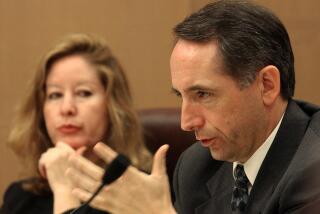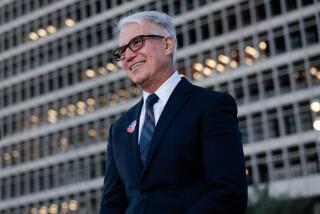A Study of Diverging Careers in the Geronimo Pratt Case
- Share via
Occasionally, a case comes along that allows citizens to peek under the rug to see how the judicial system hides its dirt. The case of Black Panther Elmer “Geronimo” Pratt, whose murder conviction was based on the now dubious testimony of a police informant, provides such as an opportunity.
In 1980, Long Beach Municipal Judge George William Dunn was assigned to the Court of Appeal to hear Pratt’s first habeas corpus review, eight years after his conviction. Lower-court judges are invited to sit temporarily on appellate cases by the Judicial Council. The council may have chosen Dunn because it wanted an African American face on the panel. In any case, Dunn dissented, in a 2-1 opinion, asserting that Pratt did not receive a fair trial. What’s remarkable about the 161-page opinion is the extraordinary attack of Justices L. Thaxton Hanson and Mildred L. Lillie on Dunn’s legal reasoning. It was an example of two white, ultraconservative judges slaying the messenger because they did not like his message.
What had Dunn written to warrant outrage? Here is the second paragraph of his dissent:
“A trial which is not fundamentally fair is no trial at all. It is a non sequitur to argue that a defendant is obviously guilty if it is an established fact that the defendant was not afforded a fair trial. This case, like all cases, invites the question, can any defendant feel assured, no matter how apparent his guilt may appear from an examination of the prosecution evidence that he is, under our system, afforded due process? If the answer is not affirmative, if the procedural methodology adopted in our trials lacks fundamental fairness, then the price we pay for a conviction is more costly than we may surmise--the loss of the foundation of any free society--untarnished administration of justice.”
The idea that Black Panther Pratt did not get a fair trial evoked this response from the majority:
“The dissenting opinion has bought hook-line-and-sinker defendant’s arguments in his petition, which, when dissected and analyzed, have as little substance as a handful of fog. Reliance on some nebulous concept that a fair trial was denied defendant, based solely on allegations which are wholly speculative and conjectural and admittedly unproven, not only defies logic but ignores the standards set by the Supreme Court. . . . Again, [these are] mere allegations of ‘governmental improprieties’ based on pure surmise and speculation. . . .”
The majority went on to explain why Pratt was not entitled to a hearing on the ground the star witness against the Black Panther had been a secret informant who had received money to buy a gun and a sweetheart plea-bargain deal in return for his testimony.
Eighteen years later and after having spent 27 years behind bars, Pratt was given his evidentiary hearing. That “handful of fog” had grown so unwieldy that the justice system was compelled to issue a Mayday call to keep its integrity afloat. In June 1997, Pratt was released from prison after Judge Everett W. Dickey ruled that prosecutors at his 1972 trial had concealed evidence that could have produced an acquittal. On Feb. 16, a Court of Appeal unanimously affirmed Dickey’s decision, and the following day, Dist. Atty. Gil Garcetti dropped the case. Dunn’s dissent was vindicated. The allegations of police and prosecutorial misconduct that Hanson had called “wholly speculative” turned out to be true.
So what happened to Dunn’s career?
It went nowhere. Sure, he served as a judge for 24 years, much of it on assignment to the Court of Appeal, where 60 opinions and dissents of his were published, a relatively high number for a trial judge on appellate assignment. But Dunn was not appointed to the Superior Court, much less to the Court of Appeal. Why?
Dunn offered something largely unheard in appellate conferences: a black perspective. Skin color may not change legal reasoning, but it certainly can influence one’s point of view. In seeing a nightstick, for example, an African American is more likely to reflect upon the circumstances of the recipient than the wielder. Such a perspective was anything but mainstream. What made Dunn controversial and provocative in 1979 was that he demanded a new trial for a very unpopular man who represented a very unpopular group and was charged with a heinous crime. For that, his career may well have suffered.
Not only was Dunn not elevated, but no African American has been appointed to Los Angeles’ 2nd District Court of Appeal since Dunn wrote his dissent in December 1980. The only black judge on the 2nd Appeal Court is Vaino H. Spencer, who was appointed by Gov. Edmund G. “Jerry” Brown earlier in 1980. Another African American jurist, Superior Court Judge Candace D. Cooper, had a shot at being elevated to the court. Named by the Los Angeles County Bar Assn. as trial judge of the year in 1993, Cooper was nixed by Gov. Pete Wilson for mentioning in her acceptance remarks that Wilson had not appointed any black judges to L.A. courts in his first 28 months in office.
In contrast to Dunn’s judicial fate, the careers of Pratt’s prosecutors have fared much better. The chief trial prosecutor, Richard P. Kalustian, was appointed to the Superior Court by Gov. George Deukmejian in 1985. The deputy attorney general who initially defended the propriety of Pratt’s trial, Michael Nash, was appointed to the Municipal Court in 1985. Nash is now the presiding judge of the Juvenile Court.
After nearly 25 years on the bench, Dunn, the senior African American jurist on the L.A. County bench, retired earlier this month. Despite his years of service as an appellate-court justice, he will receive the pension of a Municipal Court judge, roughly $2,100 a month less than that of a justice.*
More to Read
Sign up for Essential California
The most important California stories and recommendations in your inbox every morning.
You may occasionally receive promotional content from the Los Angeles Times.










